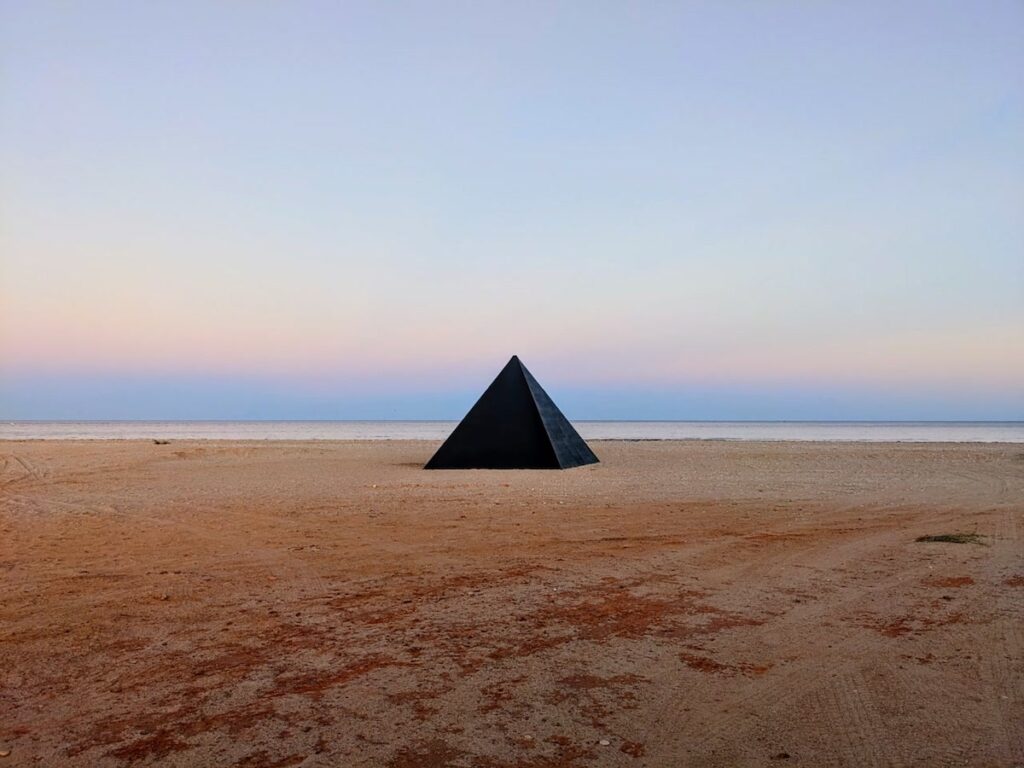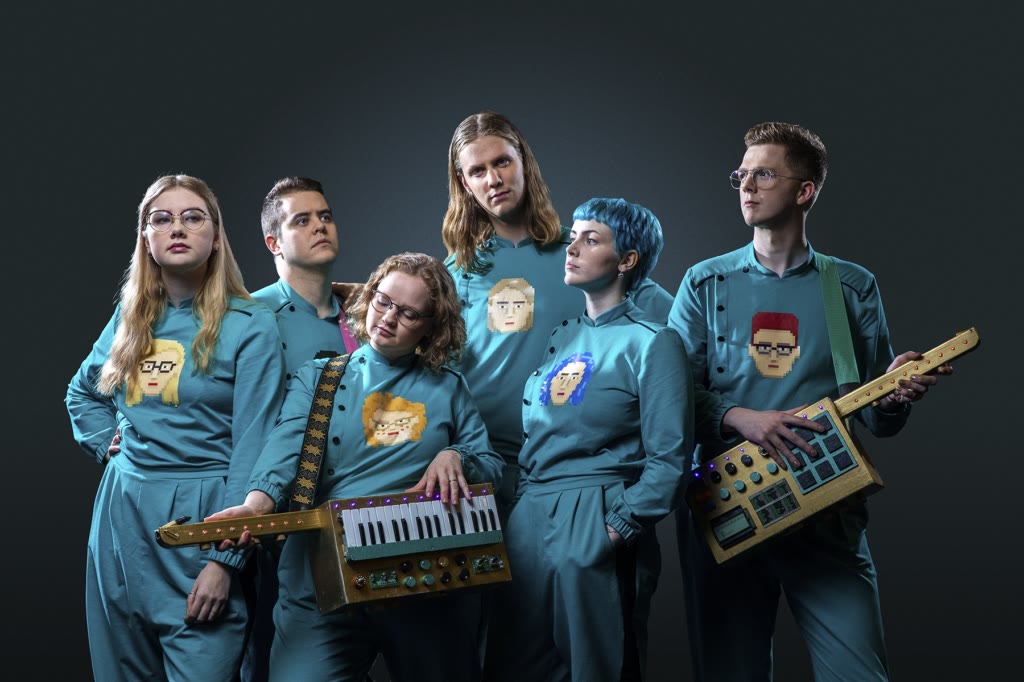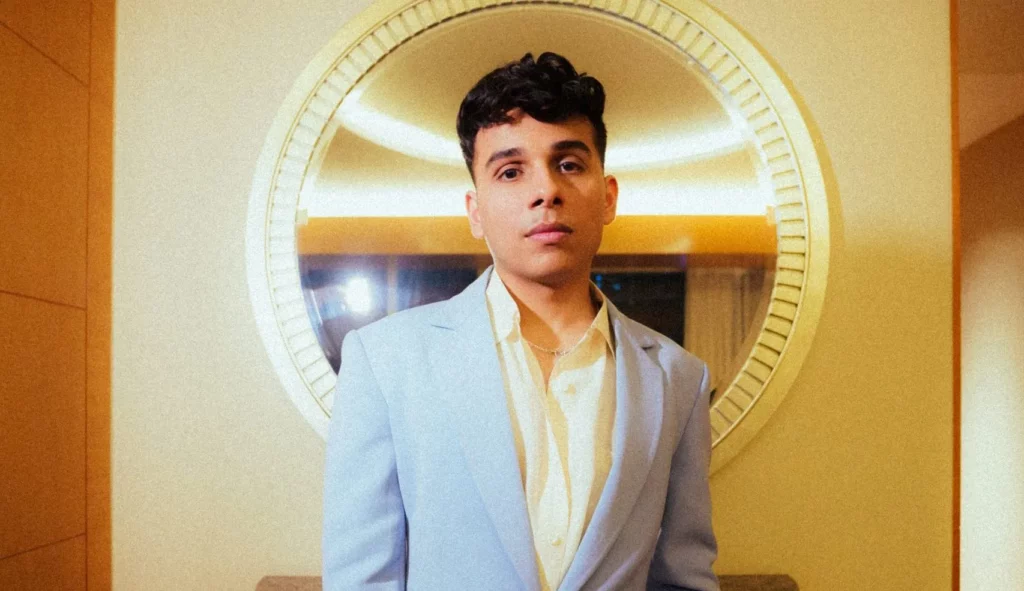Behind The Campaign :: Gold Bars

Gold Bars was a joint marketing effort between Mars (via EssenceMediacom Germany) and Sony Music Germany, designed to focus on both established and emerging hip-hop acts. The initial ideas behind the campaign were formulated in September 2021, the campaign itself started in mid March 2022 and ran until October 2022. It overlapped with Sony’s existing multi-platform Alles Gold brand. Here the team behind it explain how it was developed, how the acts from all corners of German hip-hop were recruited, why ensuring authenticity was key and how it could now be extended to other markets.
Team members
- Frank Olma – executive creative director at EssenceMediacom German/[m]Studio Germany
- Sandra Pfeiffer – director of original content at Sony Music GSA (Germany, Switzerland, Austria)
- Jan Studt – head of media & new business at Sony Music Partnerships GSA (Germany, Switzerland, Austria)
Statistics
- Overall over 200 million campaign impressions
- Over 150 content pieces created
- 17 artists involved
- Eight-month partnership
- Video portraits outperforming watchtime benchmark with >1min watchtime on average
Table of Contents
- Actionable takeaways
- Never underestimate the power of a good pun to help shape a campaign
- “Authenticity” is overused, but ignore it at your peril
- Testing the format on TikTok and then taking it on the road
- Brand safety is hugely important, but should not make a campaign toothless
- Getting the artists to tell the same old stories again and again helps no one
- Assessing the success of the campaign
- Extending the campaign?
- Learnings
Actionable takeaways
Compiled by Music Ally’s team of marketing experts, these condensed action points are to help you get started and apply them to your own work:
- Even if brand partners might prefer shorter campaigns, consider pitching for longer campaign timeframes to create long-lasting impact. For Sony Music’s Snickers campaign, this allowed them to create multiple content formats (and 150 pieces of content) that were building a new audience for Snickers.
- Understand your platforms and lay out your campaign accordingly. Sony Music started their campaign by dropping a format on TikTok called GoldBars to reach and engage the Gen Z audience. This eventually led up to dropping their hero content, which were five-minute interview videos on YouTube.
- Amplify a campaign by combining digital & real-world strategies: involving artists in tours abd live performances in addition to the digital content strategy is a great way to do this.
- Interesting brand partnerships require a deep understanding of the artists involved to create exciting content. For example, the team knew that Kool Savas, probably the most legendary artist involved, is very well known and has been well documented. Therefore, they had to ensure that his interview would bring in a fresh perspective, rather than repeating well-known narratives or stories.
- Think about ways that create a positive brand association and awareness that does not need to include pushy sales messages. By brainstorming campaign ideas that had a strong connection to both the German hip-hop scene as well as the Snickers brand, Sony Music was able to successfully promote the brand in engaging ways. This also resulted in artists coming up with their own ideas to promote the brand while doing something their fans would enjoy, such as Pajel deciding to throw some Snickers into the crowd.
- Consider international expansion: successful campaigns in one region can be adapted to other markets. This requires coordination between regional and international teams, but the payoffs in terms of brand reach and recognition can be significant.
Never underestimate the power of a good pun to help shape a campaign
After a brainstorming session between Sony and Mediacom specifically around the Snickers brand, the teams arrived at the headline “Gold Bars”, a word play on both chocolate bar and rap bar. The serendipity of this pun allowed the creative ideas to run in a multitude of directions.

Jan: We were conceptualising what we could do with Snickers in the audience world of Alles Gold, our rap editorial brand, with channels on TikTok, Instagram, YouTube and Spotify. One key moment was bringing everyone together in Berlin. We had a workshop in our office here, bringing the brand, the agency, the production company and us together, thinking about what it could mean and what we wanted to do. It was very important to find the DNA of Gold Bars.
Sandra: That really helped for the whole campaign – that we had the same vision and that everyone was on board. We created a lot of ideas on that day and it was difficult to concentrate on just one concept to move forward. It was definitely good teamwork.
Frank: Gold Bars is a nice term and it fits with Alles Gold. Snickers is the brand that says, “You’re not you when you’re hungry.” We twisted the term a little bit to say, “You can’t go gold [i.e. receive a gold record] when you’re hungry,” on the one hand; but you have to stay hungry in the hip-hop game. They have the hunger for more.
A bar is also a measurement in music theory – like spitting bars in hip-hop as well as the chocolate bar. So there was a fit. We reverse engineered these things and also talked later on to our artists. We asked them: what were the lyrics that went gold that brought them on stage?
Mars had to be convinced to work with the younger audience and to connect the Gen Z audience with the brand. Since hip-hop is the number one genre worldwide, and also in Germany, this was a perfect fit.
But we also had to convince our client that it was the perfect match to work with Sony.
We also had to get the idea to the artists and ask them: what are your gold bars? All the artists involved – Alicia Awa, Kool Savas and Pajel – have had major hits. That was the basic idea that everyone understood.
Sandra: At the starting point of the campaign, we also had Scorpion Gang, who are more part of the street rap culture, and Nina Chuba, an upcoming female artist, involved.
“Authenticity” is overused, but ignore it at your peril
Of all the genres, hip-hop is arguably the one where the notion of the authentic is the most important. As such, doing something that can be read as inauthentic can kill a campaign stone dead. It was important that the acts involved were not just German but also were split between heavyweight names and emerging names across a range of sub-genres within hip-hop.
Sandra: We wanted to do something for the hip-hop community and for the culture – and so we started to collect the right artists for it. That was a different starting point from what we normally have. When we had the idea and the concept, we tried to select the artist that represented the whole genre.

When you talk about German hip-hop, you have different sub-genres. We tried to build these up and to reach different target groups.
We searched for upcoming artists, hyped artists, who are probably known from TikTok, and well-known/established artists like Kool Savas.
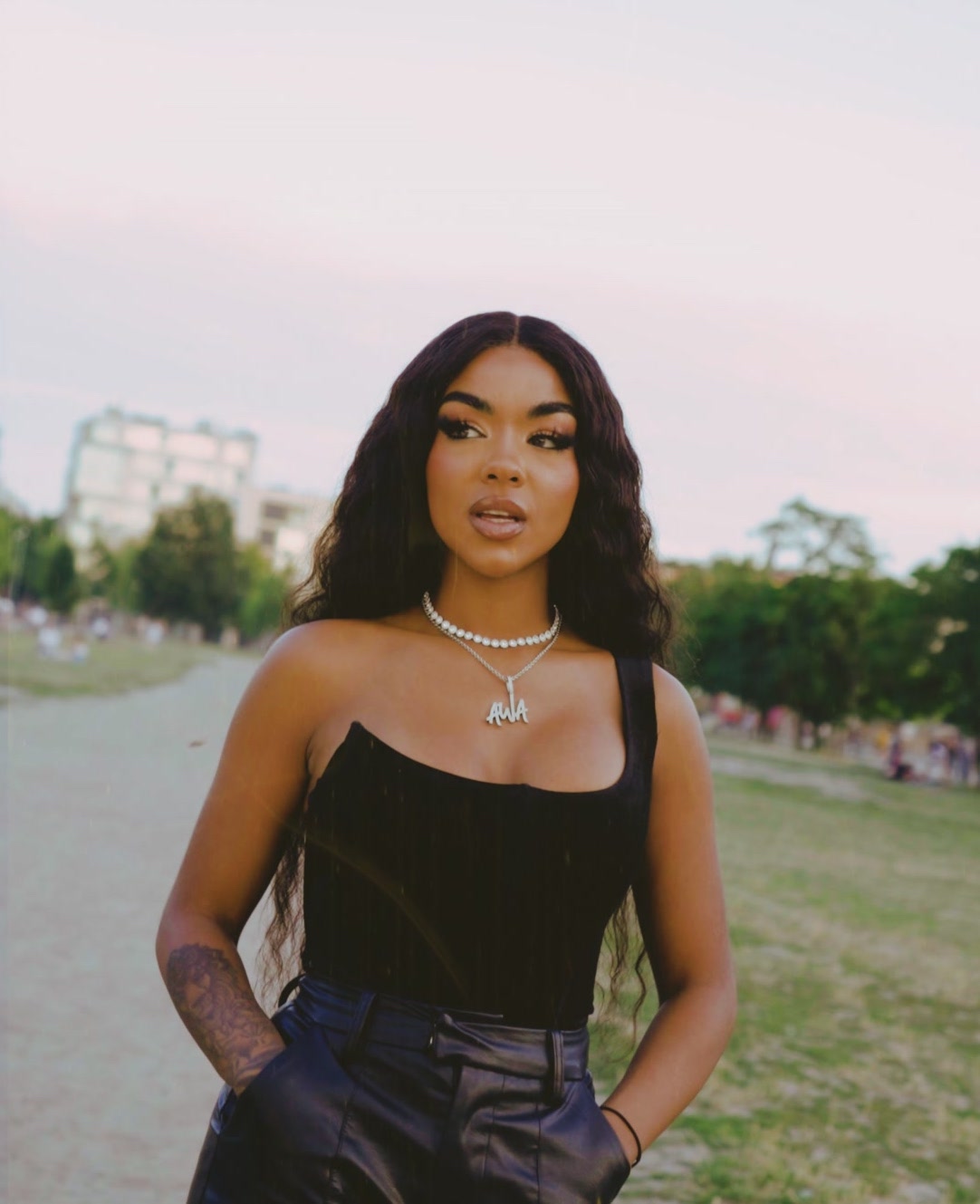
It was very important to work with younger artists but also established ones as well as with rappers and with singers to represent every aspect of the culture.
Jan: Pajel, one of the most hyped newcomers was already multi-platinum and Alicia Awa represented the singer side.
Kool Savas is already 30 years in the game and his name in the German scene is King Of Rap. He really brought weight to the campaign, which was important. I think we had a very good mix at the end and that helped to get the reception we got.
Sandra: When searching for the perfect artists for that campaign, we talked to our labels and checked their release plans so that we could support the artist in their schedule perfectly.
We wanted to support the newcomers and we wanted to give them the room to present themselves but not be put into a frame that doesn’t feel right for them.
Frank: This was also a nice campaign from a creative perspective. We pushed the Snickers brand a little bit to have the connection, but there was not a [hard sell]. It was a nice placement and the artists were not forced to bite into a Snickers or show off the brand.
Sandra: At one show, Pajel came up to me and asked, “Should I throw some Snickers into the crowd?” He just went on stage with Snickers bars and threw them to the fans. No one pitched that to him.
Testing the format on TikTok and then taking it on the road
While the idea could spin off in many directions, the original plan was to move cautiously and test the waters with short content on TikTok before taking the campaign wider, initially by getting the acts involved to tour – forging the connection between the digital world and the real world.

Jan: Gold Bars is a YouTube format featuring five-minute interview videos. We did a campaign over eight months leading up to those YouTube videos; we didn’t start with them. We actually started with a TikTok format called Gold Bars.
We had artists here in our studios in the Berlin office recording a short snippet for TikTok, talking about one line that made them successful. One of our newcomer formats on YouTube is called This Is, where Snickers was already present within the culture.
Frank: There was also the live aspect where they went on tour and Mars was the sponsor.
Jan:
What was important for us was to have a soft start and just get the logo in our channel, make our audience familiar with Snickers, test the reaction, check if there was negative sentiment, which there wasn’t. It was a good brand fit within the genre of hip-hop.
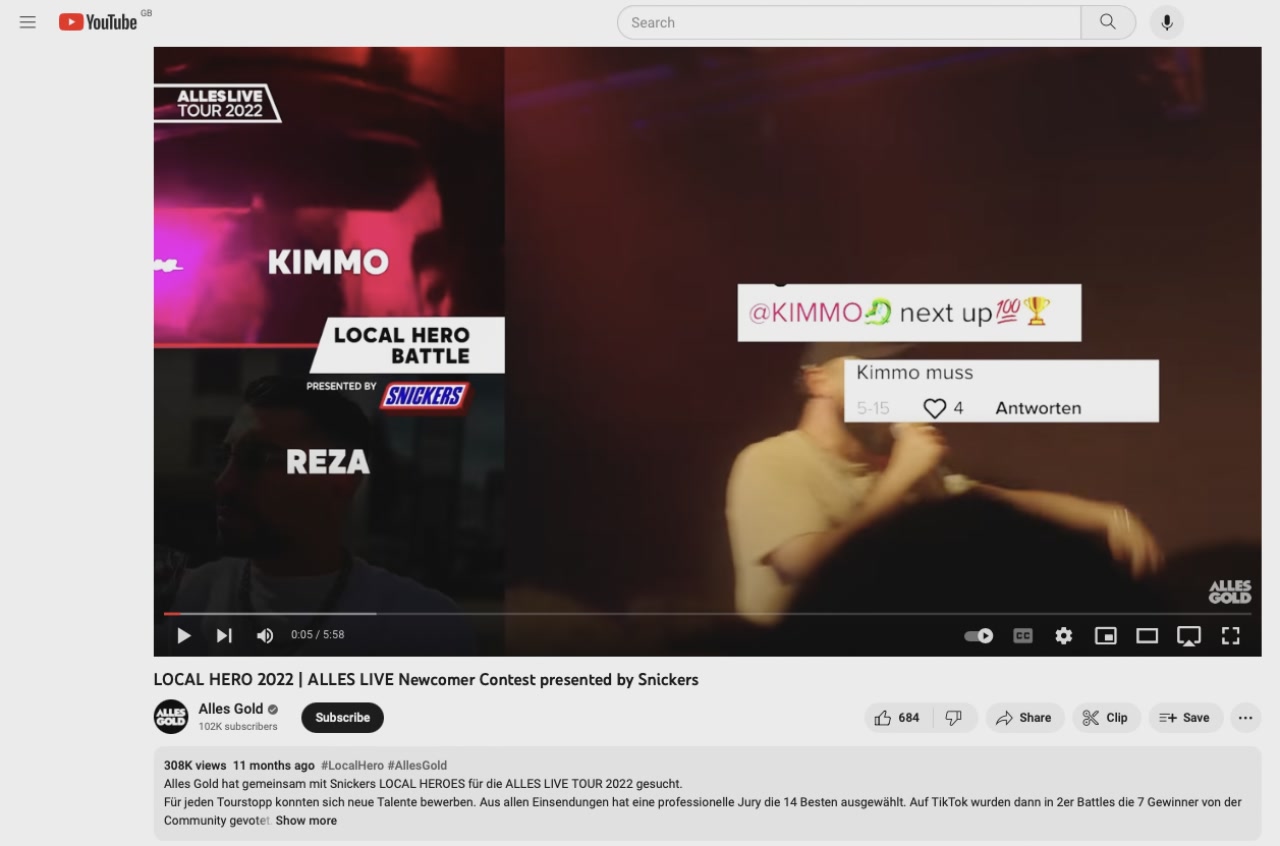
In the newcomer format, Pajel, as he was already featured in the first step, became the face of the campaign. It happened organically because it was such a good fit. In late summer 2022, we had a lot of media push from Mediacom. Mars invested budget to make our content visible. We released new YouTube shows every week.
Frank: When the artists went on tour, we also had a small competition, called Local Heroes, for up-and-coming acts. There was a certain feature in some cities where they could come up on stage and perform their gold bars. That was also a nice twist to it. So there were even more artists, although they were not signed to Sony.
Sandra:
We wanted to give something back because that’s also part of the hip-hop game.
We opened the stage for these Local Heroes. Pajel was the one shouting out on social media, saying, “Hey, guys, I started just a year ago. Now I’m here. I want to have you on stage as well. Send us your gold bars, your lyrics, your performances, and then you can win a slot on stage.”
Brand safety is hugely important, but should not make a campaign toothless
Any brand getting involved with music must understand there is a risk: musicians are creative people and do not always stick to the script. They can and will both say and do things that could be controversial so brands need to factor that in and not try to censor or geld the acts they are working with.
Jan: There was a minor issue around brand safety.
We wanted to be authentic, so all the artists [involved] are super authentic. We had to convince the client not to censor the content.
We also teamed up with the music journalist who did the interviews for the artists to ensure they spoke freely. Of course, in the end, we did some editing for some things, but not censorship. This was something we felt was very important to us since we wanted to reach the audience and have brilliant content.
Getting the artists to tell the same old stories again and again helps no one
There is much talk about originality of content, but knowing the long history of the artists is key so they are not wheeling out the same anecdotes over and over; instead the focus must be on fresh angles to bring out fresh stories and fresh ideas.

Jan: Those artists [involved] are more or less well known. So we had to add something new to the game and not just tell the same story again and again.
Kool Savas is very well known and very well documented. He has appeared on German TV for many years. So what is one aspect [about him] the audience and the fans did not know? We had scripts and we went all through the dialogue and then they had a full day of filming and interviews for the YouTube format.
There were over 150 content pieces within this campaign. We did a lot of content.
Assessing the success of the campaign
Having very clear goals from the start of a campaign means success metrics are defined from the off. In this case there were commercial targets, social media audience targets and cultural targets, the last of which is much harder to measure.
Jan:
We set out two main goals. The first goal was that we present a diverse lineup and give them a strong media reach, even the smaller artists. The second goal was to create content and awareness for Alles Gold, our own channel.
In representing a diverse lineup, I think we succeeded. There were 17 artists involved, all sub-genres included, male artists, female artists, legacy artists, newcomer artists. There was strong media reach and we got nearly 200 million impressions in the relevant target group of 18-34-year-old rap and hip-hop fans.
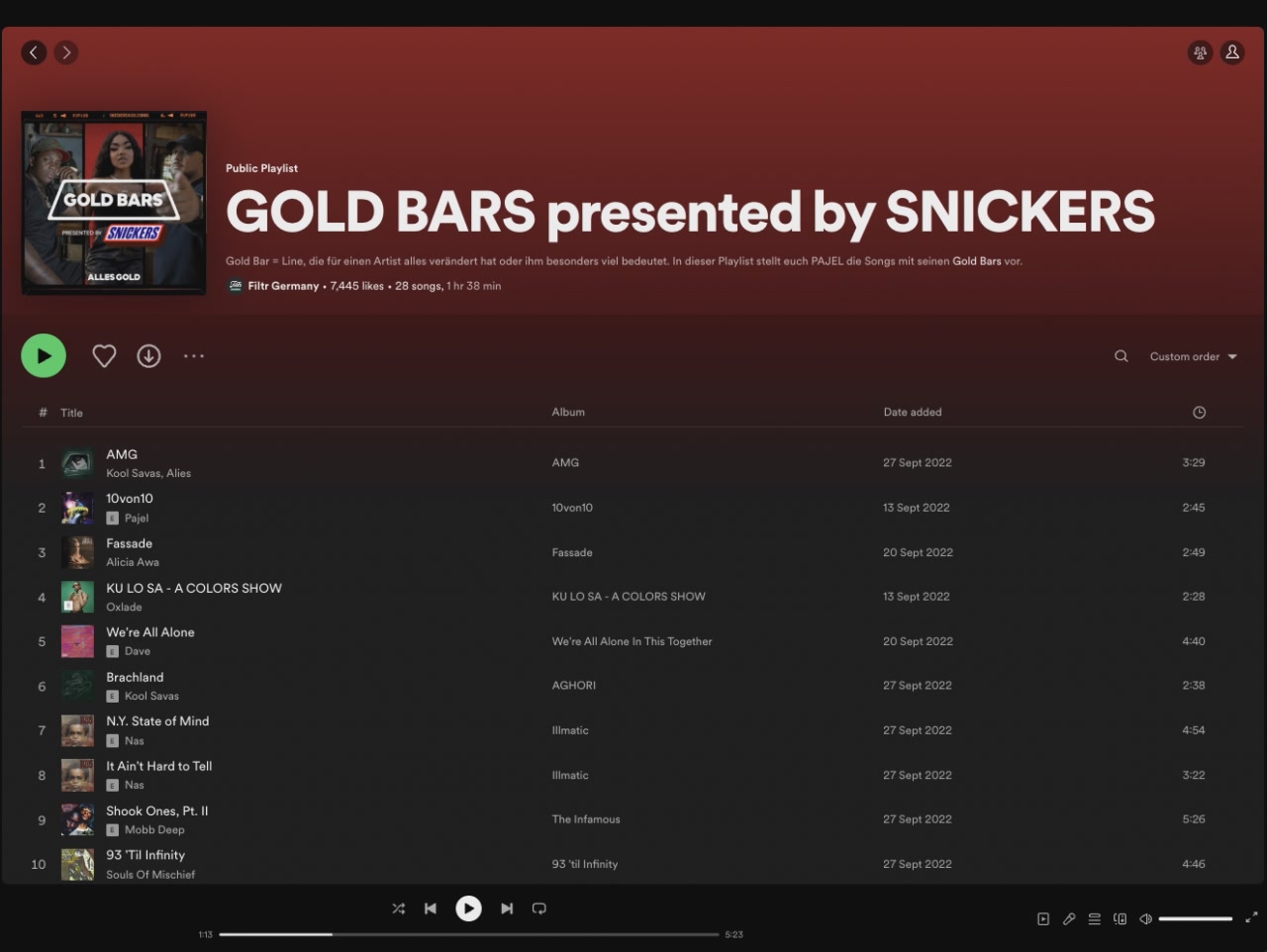
Everyone in Germany who is interested in hip-hop got a glimpse of the campaign, which was our main target. This helped to fulfil our second goal – to create awareness for Alles Gold.
We saw an increase in brand awareness for Alles Gold and for Snickers as well.

Jan: Snickers invested budget to advertise the interview content. That was not all organic traffic. We had an average view time of above two minutes for content pieces of five minutes in total, so people were really interested in that advertisement. People came from an advertisement and were just so interested and engaged with the content that they spent 120 seconds on it, which you cannot achieve with other forms of advertising.
That is a stellar success, showing that the connection between brand advertisement and music content can work. With the organic traffic, the average view time was higher because those viewers are already fans of Pajel. Our goal was to reach a new target group and get people excited for Pajel who might not have heard of him.
From our perspective, we love to work with brands on bigger timeframes. Having eight months to develop something – and to do it with multiple formats and multiple artists – makes us happy.
Brands tend to think about campaigns with a timespan of three weeks, four weeks, five weeks, and this ends up being just one thing like a music video placement, for example, and then it is gone.
What I love about this campaign is that we took time to develop something and really supported the culture.
Extending the campaign?

The Gold Bars was initially conceived to run for around half a year, but was deemed to have been more successful than originally anticipated. It could be revisited or revived, but would have to be more refined and even more focused the second time around.
Jan: From our perspective at Sony Music, we would love to continue. I think we learned a lot from the first campaign timeframe and we want to improve on the things we could do better.
There are issues of budgets and brand strategy. But we are in constant talks with Mediacom and Mars and we are looking at pursuing this or other opportunities for them. But due to constraints out of our limits, there isn’t a direct successor plan right now.
Frank: Of course we’d like to continue. Sometimes brands, generally speaking, tend to move their attention to another topic. I told Mars, like I tell every brand, “Let’s continue. Let’s follow a certain path because then our young audience will manifest and then the idea manifests within them.”
Brands tend to be too quick – “Oh, we’ve done that” – and they don’t want to continue. Generally speaking, we want to work with Sony Music on different topics. Sometimes a brand strategy changes.
We said, “The term Gold Bars Presented By Snickers could also be presented by another brand out of Mars.” We already talked about that within this campaign.
Mars is always keen on the results and their colleagues in the US and UK are highly interested [in the campaign], so it is a highly successful case for us as well.
It could be expanded internationally.
Jan: This would take an effort from the German Mars marketing team, who presented this case internationally and got a great reception. We would love to make a handshake with our international colleagues because Sony Music is in every territory and there are interesting, successful and hyped artists in every market. We would love to take this concept to another market and have our colleagues and Mars do the same.
It was a regional campaign and only took place within Germany, but the concept and the idea are definitely applicable to other markets.
Learnings
- Paying lip service to abstract notions of “authenticity” is never going to be enough. When dealing with a genre like rap, anything deemed inauthentic by the audience will be immediately sniffed out, so the genuine, rather than the platitudinous, has to be the priority at all times.
- A solid pun can unlock all manner of creative avenues and give a campaign direction in entirely new ways. Even if the pun does not make the final campaign, using it when workshopping ideas can help focus things down or point to a range of options.
- For a major campaign designed for major platforms, quietly road testing it on smaller platforms can help iron out any problems so that it lands better when the full campaign activation mode begins.
- Digital marketing intersecting with real-world activations is still the most powerful approach. Online gives infinitely greater reach, but in the real world is where proof of concept can really be shown off.
- Having brands involved, especially with artists who do not care for media training, is always going to be risky; but brands need to understand that artists might not always quote directly from their brand guidelines (or they might do/say something controversial) and need to accept this as part of the process.
- Brand campaigns with artists need to have something unique and have the artists reveal something new. A campaign that rehashes old stories shortchanges everyone – the brand, the artists and the audience.
- Having clearly defined goals from the very start means success can be measured properly and honestly.
- Bringing a territory-specific campaign to other markets is obviously great, but understanding that some campaigns work best in individual markets and that trying to internationalise them will only be a case of diminishing returns.
